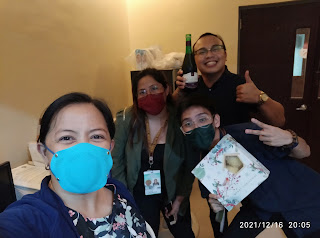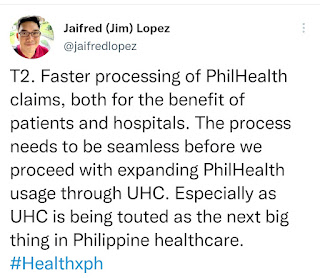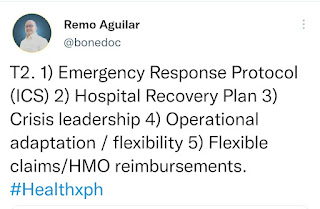For almost two
years now, the world was pre-occupied with responding to the COVID-19
pandemic. We take a look at another
pandemic, just as important, as it affects us here in the Philippines – the
HIV/AIDS epidemic. As of August 2021, the
HIV/AIDS & ART Registry of the Philippines reported 90,031 confirmed
HIV-positive cases since January 1984.

An HIV diagnosis will change your life.
Living
with HIV can increase the risk of stress, anxiety, and depression. The most frequent stressors experienced by PLHIV at diagnosis
were confidentiality (93.2%), risk of infecting others
(86.9%), distressing emotions (86.3%), physical functions (83.9%), and
disclosure concerns (83.7%) (Huang, 2020).
What is HIV
Disclosure?
HIV
DISCLOSURE is the personal experience of communicating to another individual or
group of individuals that you are a person living with HIV. HIV disclosure is central to debates on HIV because of its
potential for HIV prevention on the one hand, and privacy and confidentiality
as human rights issues on the other (Obermeyer CM, 2011). Disclosure of HIV status is an essential part
of behavior modification and access and adherence to treatment in people
infected with HIV (Norman MA, 2007)

Unfortunately, existing HIV disclosure laws in
the US seem to contradict rather than complement public health efforts to
prevent the spread of HIV (CL Galletly, 2006).
By singling out persons who have HIV in a criminal statute and by
criminalizing sexual behavior that would be legal for HIV-negative or untested
persons, these laws link HIV-positive status with criminality, potentially
reinforcing the stigmatizing attitudes that public health leaders identify as
significant barriers to prevention efforts.
The public health response to HIV/AIDS is
founded on the following key recommendations.
- practice
safer sex correctly, consistently and universally
- seek testing and take steps to eliminate or modify
behaviors that put them at risk
- HIV-positive persons are encouraged to seek
treatment, to apprise past sexual partners that they may have been exposed
to the virus, and to avoid behaviors that would put future partners at
risk.
We are fortunate in the Philippines to have the Republic
Act 11166 or the HIV AIDS Policy Act of 2018, which provides the following:
- Extended scope of HIV
education and information, which shall form part of the constitutional right to
health
- Evidence-based,
gender-responsive, age-appropriate and human rights-oriented prevention
programs and measures. Goals are to
reduce risky behavior, lower vulnerabilities, and promote human rights of
PLHIVs
- Testing and
counseling made accessible to the young population – voluntary, confidential,
available all the time with informed consent, extended to persons aged 15 or
over, child below 15 who are at higher risk of HIV exposure any young person
aged below 15 who is pregnant or engages in high risk behavior
In fact, there are stricter penalties
for violation of confidentiality, a comprehensive
treatment, care and support program for PLHIVs and higher penalties for
discrimination based on HIV status
This translates to better access, better education,
better care and better partnerships.
DISCLOSURE AMONG HETEROSEXUAL ADULT PLHIV
In 2008, Arnold et al researched on
disclosure among heterosexual adult persons living with HIV in different
relational contexts: with partners, family members, friends, healthcare professionals
and in work settings (Arnold M, 2008).
Disclosure is higher among women than men,
among Latinos and whites compared to African-American families, and among
younger compared to older HIV-positive adults.
Disclosure
decisions are often made to tell everyone, someone or no one. (Arnold M, 2008)
- EVERYONE
- Makes HIV status a central attribute of one’s identity
- SOMEONE
– Requires strategic decisions based on context
- NO
ONE – requires strategies for securing social support while remaining anonymous
Disclosure
decisions are central to personal identity.
Disclosure is intimately related to how communities stigmatize or accept
PLHIV and how individuals perceive themselves, their identities and their roles
in the communities
DISCLOSURE AND TYPES OF SOCIAL RELATIONSHIPS
Here are some tough questions on
Disclosure of HIV+ Serostatus
• If an individual is HIV+, is it their responsibility to
disclose to their sex partner?
• In your opinion, how or when should a person living with
the virus disclose their HIV+ serostatus to potential sex partners?
• How likely are people
to disclose their HIV+ serostatus to casual sex partners?
• If someone is having
unsafe sex, how likely are they to disclose their HIV+ serostatus?
• Of those who do not
disclose to all partners, how do you think they make the decision regarding who
to tell and who not to tell?
• How truthful are
people (or do you think they lie) in telling their HIV+ serostatus when they
have intimate contact (sex, needle sharing) with others and why?
• In your opinion, what is the best method to encourage
disclosing a person’s HIV+ serostatus with current and potential sex partners?
• What are your thoughts and feelings regarding disclosing
to persons other than sex partners?
Model on HIV Disclosure and Types of Social
Relationships
Social
relationships were categorized as sexual and nonsexual, with varying degrees of
HIV disclosure, depending on the social relationship with the person to whom
one did or did not disclose.
· HIV
is still a fearful and stigmatizing disease, and disclosure of HIV status is a
complex phenomenon embedded in various types of social relationships. (Bairan, 2007)
· Disclosure of one’s
HIV+ serostatus depends on (1) social relationships (2) fear, and (3) stigma,
with social relationships being the predominant theme
· Social
relationships - Concerning sexual relationships, some participants defined
nondisclosure of HIV+ status to casual sex partners as ‘‘anonymous sex.’’ Being a gay man, I have relations with people
that I don’t e.ven know. I don’t want to know your name. So I don’t tell them
[disclose] right off the bat. And if I don’t say that [I’m HIV+], well now, the
sentence is 10 years in jail.’ if you don’t expect to see them again, you
wouldn’t disclose. The main reason given
for not disclosing was that the HIV+ person wanted sex. A subject shared that he
would not tell a casual sex partner but would tell his partner if he was in a
long-term relationship. Most
people, when they find out that they are HIV+, go through a period that they
DON‘T disclose. It’s
different with every person.
DISCLOSURE AND HAART
Is disclosure associated with HAART
adherence?
Four groups of factors have been associated
with adherence to highly active anti-retroviral therapy: (1) patient factors;
(2) medication characteristics; (3) interpersonal characteristics (e.g. social
supports); and (4) the general health care system. The relationships between decisions about
disclosing and about starting and adhering to highly active antiretroviral
treatment (HAART). Does disclosure
always facilitate adherence? Does adherence facilitate disclosure? Many
advocates have hoped that improved treatment would lessen the stigma associated
with HIV and ease the lives of PLWH.
Medications may ‘out’ people living with
HIV. Disclosure of HIV and/or HAART may
also result in antagonism from others who hold negative attitudes and beliefs
about HAART, potentially impeding adherence.
Conversely, medications may improve appearance, delaying or impeding
disclosure. HIV disclosure can lead to
support that facilitates initiation of, and adherence to, treatment. HIV
disclosure and adherence can shape one another in critical ways (Klitzman,
2004)
PARENTS DISCLOSURE OF HIV TO THEIR CHILDREN
Parents were more likely to disclose to older than younger children. Mothers were more likely to disclose earlier than fathers and they disclosed more often to their daughter than to their sons (Lee, 2002).
Disclosures
impact adolescents negatively. Healthcare
workers need to discover how to reduce this impact. Clinical
literature suggests that family secrets are destructive. The
negative impacts of disclosure on both parents and their adolescent children
persist for a considerable period of time. Parents who disclose report
significantly more stressful life events, family stressors, and perceive that
their children experience HIV-related stigma.
As
the quality and duration of life for PLH has increased, there appears to be
less urgency to disclose one’s serostatus to children. The
medical setting offers a venue for providing support regarding decisions about
whether, when and how to disclose their serostatus to their children.
If
parents are discouraged from disclosing, an implicit message is communicated
that HIV is stigmatizing and must be hidden. We are not advocating hiding one’s
status. Yet, we need to understand that
disclosure takes courage, planning and a lot of time in a long process to
reduce negative impact of disclosure on both the parent and adolescent.
Healthcare workers
must take care to avoid involuntary or unplanned disclosures. More efficient process flows must be
developed during testing, linking to care, contact tracing, immigration, in
dealing with legal cases and managing accidents and gossips.
It is
important to know the stages of adapting to life with HIV, which goes thru each
step of the process, including: shock, denial, anger, bargaining and
depression. This allows healthcare
workers to adjust, provide support and assist the PLHIV in disclosing their HIV
status to prevent transmission and access care.
The
disclosure process would vary from person to person and their tolerance for
coming out. Considering the possible
negative impact of HIV disclosure, the process involves recover and support,
education, preparation, planning, disclosure and the follow up after the
disclosure.
More attention should be paid to PLWH with
younger age, not living alone, less income, presence of HIV symptoms, and lack
of social support (Huang, 2020). Disclosure is believed to affect health,
mental health, disease transmission and the quality of relationships; the
importance of disclosure behavior will only increase as treatments and life
expectancies improve.
I remember one young man who mustered enough courage
to disclose his HIV status to his strict parents. In the process, he had to reveal the fact
that he was gay as well. When his
parents failed to accept him as their child, the young man fell into deep
depression and committed suicide.
The
bottomline is that role of disclosure for HIV prevention should be balanced
against the person’s privacy and confidentiality as human rights issues.
References
Arnold M, E. R.-B. (2008). HIV Disclosure among
adults living with HIV. AIDS Care, 80-92.
Bairan, A. (2007). A model of HIV disclosure: Disclosure
and types of social relationships. Journal of the American Academy of
Nurse Practitioners, 19, 242-250. doi:https://doi.org/10.1111/j.1745-7599.2007.00221.x
CL Galletly, S. P. (2006). Conflicting Messages: How
Criminal HIV Disclosure Laws Undermine Public Health Efforts to Control the
Spread of HIV. AIDS Behav, 10, 451–461. doi:DOI
10.1007/s10461-006-9117-3
Huang, Y. (2020). HIV-Related Stress Experienced by Newly
Diagnosed People Living with HIV in China: A 1-Year Longitudinal Study. Int.
J. Environ. Res. Public Health, 17, 2681. doi:doi:10.3390/ijerph17082681
Klitzman, R. (2004, July). Intricacies and inter-relationships
between HIV disclosure and HAART: a qualitative study. AIDS CARE, 16(5),
628/640. doi:https://doi.org/10.1080/09540120410001716423
Lee, M. (2002, November 8). Parents’ disclosure of HIV to
their children. AIDS, 16(16), 2201-2207. Retrieved from
https://journals.lww.com/aidsonline/Fulltext/2002/11080/Parents__disclosure_of_HIV_to_their_children.13.aspx
Norman MA, C. M. (2007). Factors related to HIV Disclosure
in Two South African Communities. American Journal of Public Health,
1775-1781. Retrieved from
https://ajph.aphapublications.org/doi/epub/10.2105/AJPH.2005.082511
Obermeyer CM, B. P. (2011). Facilitating HIV Disclosure
Across Diverse Settings: A Review. American Journal of Public Health,
1011-1023. doi:doi: 10.2105/AJPH.2010.300102












































